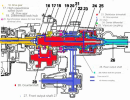kbrown934
Active Member
I have been working on a post re. power flow through the Super Select transfer case. I have found it to be a remarkably sophisticated unit. Being a horrible file manager I have issues and I am still working on it. Here is a diagram I managed to translate from the German where I found it.
The Viscous Coupling seems to be misunderstood. This diagram shows location of viscous coupling, it is at the rear of the transfer case and all power (torque if you prefer) with center differential locked, passes through it to the rear drive shaft. No power for front drive shaft goes through Viscous Coupling. I think the dark blue line is showing power flow with center differential unlocked. The lighter double blue line shows the power going through the Viscous Coupling with center diff locked.
My contention is that the viscous coupling is in the powertrain flow to absorb shocks to the system from engaging 4WD and activating the front axle at speed. It will also absorb shocks from binding when the vehicle is in 4WD (unlocked and front tires are traveling in different arcs than rear wheels on hard surfaces). The Viscous Coupling allows slippage between the forward portion of the drive train and the rear drive shaft when they are rotating at different speeds while they are coming to same speeds 1/2 the couplings plates are splined to the forward drivetrain and the other 1/2 of plates are splined to the rear output shaft. In a Viscous Coupling the internal plates do not physically touch, they are submerged in a Viscous Fluid that shears between the two sets of plates when unequal shaft speeds are applied. Generally the slippage is momentary and does not generate a lot of heat. Allowing for unequal shaft speed is a necessity for 4WD on hard surfaces (roads) that do not readily allow for wheel slippage like loose surfaces, dirt, sand, gravel, snow etc.
The viscous coupling is an expensive part. Mitsubishi engineers have kept it in the transfer case for a reason. Corporate bean counters hate expensive parts. It is also retained in the next generation transfer case, the 2005 electronic shift transfer case. However in the electronic shift unit the location of Viscous Coupling is changed, the center differential and the Viscous Coupling have swapped positions. The differential has also changed from a std. 4 pinion open differential to a planetary gearset with 3 planetary gears. The planetary gearset provides a 40F/60R% torque split where the 4 pinion diff provides a 50F/50R% torque split. When looking at exploded views I have taken to checking which diff is shown to judge which unit I am looking at.

Also in this diagram the blue dotted line shows power flow in 4WD Low.
The Viscous Coupling seems to be misunderstood. This diagram shows location of viscous coupling, it is at the rear of the transfer case and all power (torque if you prefer) with center differential locked, passes through it to the rear drive shaft. No power for front drive shaft goes through Viscous Coupling. I think the dark blue line is showing power flow with center differential unlocked. The lighter double blue line shows the power going through the Viscous Coupling with center diff locked.
My contention is that the viscous coupling is in the powertrain flow to absorb shocks to the system from engaging 4WD and activating the front axle at speed. It will also absorb shocks from binding when the vehicle is in 4WD (unlocked and front tires are traveling in different arcs than rear wheels on hard surfaces). The Viscous Coupling allows slippage between the forward portion of the drive train and the rear drive shaft when they are rotating at different speeds while they are coming to same speeds 1/2 the couplings plates are splined to the forward drivetrain and the other 1/2 of plates are splined to the rear output shaft. In a Viscous Coupling the internal plates do not physically touch, they are submerged in a Viscous Fluid that shears between the two sets of plates when unequal shaft speeds are applied. Generally the slippage is momentary and does not generate a lot of heat. Allowing for unequal shaft speed is a necessity for 4WD on hard surfaces (roads) that do not readily allow for wheel slippage like loose surfaces, dirt, sand, gravel, snow etc.
The viscous coupling is an expensive part. Mitsubishi engineers have kept it in the transfer case for a reason. Corporate bean counters hate expensive parts. It is also retained in the next generation transfer case, the 2005 electronic shift transfer case. However in the electronic shift unit the location of Viscous Coupling is changed, the center differential and the Viscous Coupling have swapped positions. The differential has also changed from a std. 4 pinion open differential to a planetary gearset with 3 planetary gears. The planetary gearset provides a 40F/60R% torque split where the 4 pinion diff provides a 50F/50R% torque split. When looking at exploded views I have taken to checking which diff is shown to judge which unit I am looking at.

Also in this diagram the blue dotted line shows power flow in 4WD Low.
Last edited:
